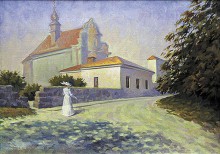Whenever we speak about Franko and places associated with him, the first to come to mind are Nahuievychi, Drohobych, Lviv, Kolomyia, Kryvorivnia, Chernivtsi, and Vienna. These are the landmark places, where he was born and raised, wrote his immortal works, and even served a jail term. But do such place names as Myklashiv (a village near Lviv), or a bit distant Hrebeniv, Skole raion; the little town of Zbarazh and the villages of Tsyhany and Zhukiv, Ternopil oblast, ring any bells to an ordinary Galicia resident? Meanwhile, these towns and villages, also linked to the name of Ivan Franko, figure in the oeuvre of the Lviv artist Oleksandr Dvorsky. Each of these places adds some touches to his life story. For example, in Zbarazh he ran, unsuccessfully, for the Austrian parliament, of which he spoke emotionally later. Myklashiv is the place where Olha Roshkevych, the young Franko’s first love, the daughter of a priest from the village of Lolyn, now Ivano-Frankivsk oblast, who he was forbidden to marry, is buried. She was a teacher in this village.
The exhibit at the Lviv National Ivan Franko Memorial Museum displays paintings and watercolors of an ethnographic nature. Take, for example, the People’s House in Zbarazh… Franko publicly spoke here during his election campaign. This town was often visited by another great writer, Vasyl Stefanyk, who would come to see his medical college classmate Josaphat Schmieger. The lady in the picture is Severyna Sorokivska who hosted Stefanyk. This building now houses the local branch of Prosvita. The other pictures show landscapes of the Carpathians which Franko loved so much, a fire in Nahuievychi, and the oak tree in the same place, under which he wrote the short story “Pencil,” hiding from the bad weather.
“I discovered my Franko by reading his works and traveling, together with museum people, to the places he had visited,” the artist says. “I understood his personality better, without the foisted stereotypes. These travels added inspiration to grasp this colossus, a giant of thought. Ivan Franko was a person who stood out in his milieu and was unsuitable because he spoke out his mind frankly. It is my second exhibit devoted to this theme. The first one, ‘Down the Roads of Franko,’ featured better-known places associated with his life.”
This artist displays a realistic manner of painting and subdued colors. “I look at the world with my own eyes and express what I see. There can be some fantasy sometimes, but it is art,” Oleksandr Dvorsky says.







